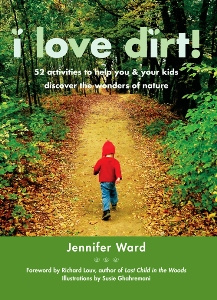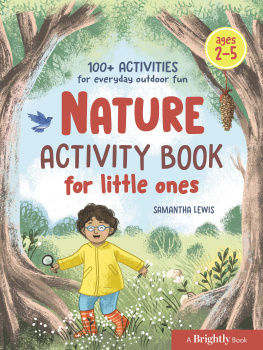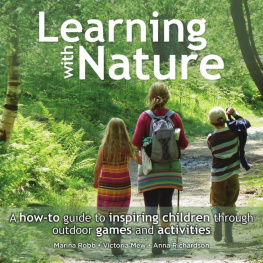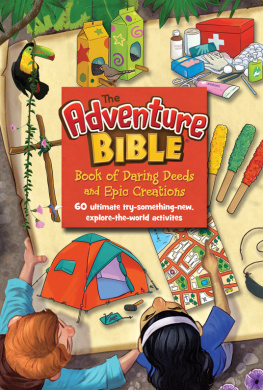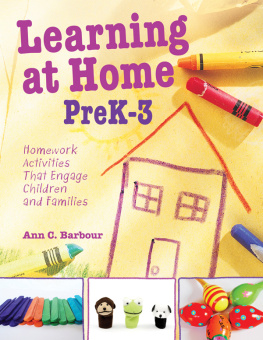Lets Take It Outside!
Edited by Kathy Charner, Mary Rein, and Brittany Roberts

Copyright 2012 Gryphon House
Published by Gryphon House, Inc.
P.O. Box 10, Lewisville, NC 27023
800.638.0928; 877.638.7576 (fax)
Visit us on the web at www.gryphonhouse.com.
All rights reserved. No part of this publication may be reproduced or transmitted in any form or by any means, electronic or technical, including photocopy, recording, or any information storage or retrieval system, without prior written permission of the publisher.
Cover photograph courtesy of iStock LP.
Library of Congress Cataloging-in-Publication Data
Lets take it outside! : teacher-created activities for outdoor learning / edited by Kathy Charner,
Mary Rein, and Brittany Roberts
p. cm.
Summary: Lets Take It Outside! combines the magic and excitement of the outdoors with activities that build math, literacy, and science skills in young children. Over 100 teacher-created, classroom-tested activities engage childrens minds and bodies as they explore the limitless bounds of the outdoors!-- Provided by publisher.
ISBN 978-0-87659-431-5 (pbk.)
1. Outdoor education. 2. Outdoor education--Activity programs. I. Charner, Kathy. II. Rein, Mary B.. III. Roberts, Brittany.
LB1047.L476 2012
371.384--dc23
2012011577
Bulk Purchase
Gryphon House books are available for special premiums and sales promotions as well as for fund-raising use. Special editions or book excerpts also can be created to specifications. For details, contact the Director of Marketing at Gryphon House.
Disclaimer
Gryphon House, Inc. cannot be held responsible for damage, mishap, or injury incurred during the use of or because of activities in this book. Appropriate and reasonable caution and adult supervision of children involved in activities, and corresponding to the age and capability of each child involved, is recommended at all times. Do not leave children unattended at any time. Observe safety and caution at all times.
Table of Contents

Think back to your childhood and how you spent your free time. Most of us remember spending a great deal of that time outdoors. Perhaps neighborhood children would gather, and a spontaneous game of Kick the Can or Freeze Tag would ensue. Or perhaps an imagined town, such as the one in the story Roxaboxen by Alice McLerran, would be created out of twigs and stones lined up in patterns. Some of us recall making mud pies and creating mud cakes with berries picked from the bushes. And if there was a local playground, we challenged our physical skills with experiments on the monkey bars or swings. If our skills were not yet perfected and we fell in our attempts, we picked ourselves up, brushed ourselves off, and often tried again.
This is the excitement of outdoor play.
Today, children in child-care programs frequently have a very different outdoor experience. By necessity, it is often limited to shorter, defined periods of time that are also more limited in scope. Children are cautioned to stay out of the mud and told to use the equipment in a manner deemed safe by adults. This may interfere with a childs desire to take a risk or test a new, physically challenging skill. It is absolutely true that close supervision by adults who know the abilities of each and every child is crucial when it comes to outdoor play. However, while safety must always be at the forefront, children must also be provided with opportunities to learn and challenge themselves in ways that can only be achieved outdoors.
We do not always realize the complexity of childrens outdoor learning. In the introduction to the CD, Outdoor Play, George Forman observes:
When children play outdoors, we expect them to run, jump, and stretch beyond what is possible in the classroom. For this reason we often treat outdoor play as a time for large motor play, group games, and sports. Teachers less often consider the high-level thinking that occurs outdoors as children solve problems, negotiate rules, construct with loose parts, and figure out how to navigate changes in the terrain.
It is important to take a look at how outdoor play time is structured. Outdoor time is a prime opportunity for children to engage in self-selected, unstructured play. However, this does not imply that the adults should stand by or that they should avoid introducing engaging new activities to involve the children. Research has shown that adult presence and involvement can enhance learning for children. So, join in, be flexible, and enjoy the spontaneity and stimulation that outdoor play offers!
Its 10:30. The children are on the playground with their teachers. Two children carefully practice their balancing skills as they place one foot in front of another and walk across a 2-inch beam that the teacher has placed on the grass. A few children are taking turns going down the slide for the umpteenth time. Two other children are pretending that they are cooking as they fill a bucket with dirt and mix it with a stick. Another child is drawing with chalk on the sidewalk path. One other child is waiting to take his turn riding a tricycle.
In addition to unstructured play time, it is valuable for children to have outdoor activities that are focused on specific learning. The learning environments we create for children outdoors can be just as exciting as our indoor environments. Activity areas can be developed to provide children with opportunities for dramatic play, large motor movements, quiet activities, nature and science experiences, and art. The teacher-created activities in this book provide a wide range of possibilities to engage childrens minds and bodies in invigorating and imaginative ways.
When we adjust our thinking to take advantage of everything the outdoors has to offer in the way of freshness, variety, and stimulation, even the simplest activity can take on a new meaning when we say, Lets Take It Outside!
On June 29, 2011 parents, teachers, children, and one elephant joined in the fun of International Mud Day. What began as an exchange between the children of Nepal and Australia, organized by Bishnu Bhatta and Gillian McAuliffe, is now an idea shared throughout the world.
~~~~
It is Thursday, and the forecast is for another day of rain and scattered showers. There is a muddy path full of puddles leading to the playground, and the worms have come out of hiding. The children have been cooped up inside. Why not go outside and play?
~~~~
Sources
Outdoor Play, part of The Learning Moments series, produced by Videatives, Inc. and available at www.videatives.com
World Forum Foundation. http://worldforumfoundation.org/wf/wp/initiatives/nature-action-collaborative-for-children/international-mud-day-2011/stories
Michelle Barnea, Millburn, NJ
There are many ways to incorporate counting and numbers into outdoor play. In this chapter you will find active games along with simple counting and sorting activities using natural objects. Let these ideas inspire your own creativity as you watch the children in their outdoor play.
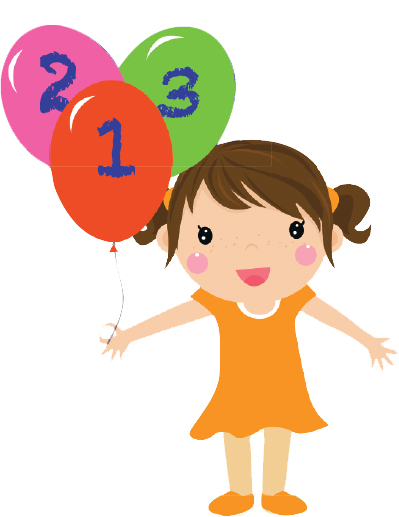
Childrens Books
12-3: A Childs First Counting Book
Next page


